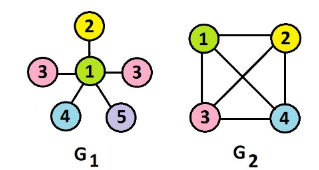Process of assigning colors to each node of a graph, where each node should have a color, and no adjacent nodes are assigned the same color.
This is similar to giving nodes “weights”, but in this case giving each node a specific color. Node coloring is often used in models that deal with conflict resolution (resolving a graph so that there are no conflict/overlap).
Time complexity
For the general -coloring problem, time complexity using backtracking is where is the number of vertices (regions on the map)
Example
Graph coloring techniques can be applied to assigning frequencies to radio stations, scheduling club meetings, and coloring the countries of a map.

Attributes
- A -coloring of graph G is a coloring of G using colors.
- The chromatic number of a graph G is the minimum value for which a -coloring of G exists.
Conflict modelling
Coloring can also model conflicts, where you would color conflicting nodes the same color, thus representing that they should not be next to each other.
For example, A-B are conflicting and cannot be next to each other, thus should both be the same color.
| A | B | C | D | E | |
|---|---|---|---|---|---|
| A | X | X | X | ||
| B | X | X | X | ||
| C | X | X | |||
| D | X | X | |||
| E | X | X |